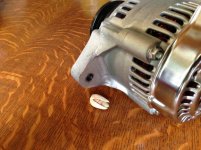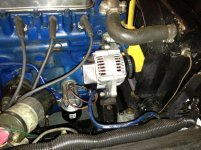I just welded up an oxygen sensor bung to the exhaust to use with my Innovate LM-2 AFR meter. It's fun to mess around with jetting when you have real numbers that quantify the flat spots and smoky grey exhaust. Before the meter, I thought the car was running well with chokes of 34, relatively large main jets of 155, and the idle mixture screw opened up a fair bit. Fuel consumption was ridiculously bad, funny at first, but now annoying.
Now with meter in hand, I jetted back down to 130, fattened up the idle jet, and predictably re-developed that flat spot under hard acceleration starting around 2500 rpm. Meter indicates that AFR starts around 11 (rich, but okay), spikes up to the 20s in the flat spot (dangerously lean), then back down to 11-12 after 3500 rpm. I'm thinking it needs richer accelerator pump jets, but now I'm questioning the choke size. I imagine that snapping open the throttle with these oversized chokes results in a sudden drop in manifold vacuum and intake velocity, more than the current accelerator pump jet can accommodate, thereby resulting in that big lean flat spot I experienced.
I've just ordered chokes in 32 and 30, and also fatter accelerator pump jets. With those size chokes, I'm firmly in DCOE 40 territory. In fact, it was only after ordering up all this carb stuff that I discovered an old, unproven Weber 40 with chokes of 30 down in my basement. Spares from my Alfa stockpile. I might as well just slap that one on and see how it runs.
Tuning this setup would be more fun if it wasn't so expensive. Then again, the new smaller chokes may pay for themselves in fuel savings. I have to use that justification because I'm too stubborn to go back to the perfectly adequate SU setup.

 Hi Guest!
Hi Guest!

 smilie in place of the real @
smilie in place of the real @
 Pretty Please - add it to our Events forum(s) and add to the calendar! >>
Pretty Please - add it to our Events forum(s) and add to the calendar! >> 


